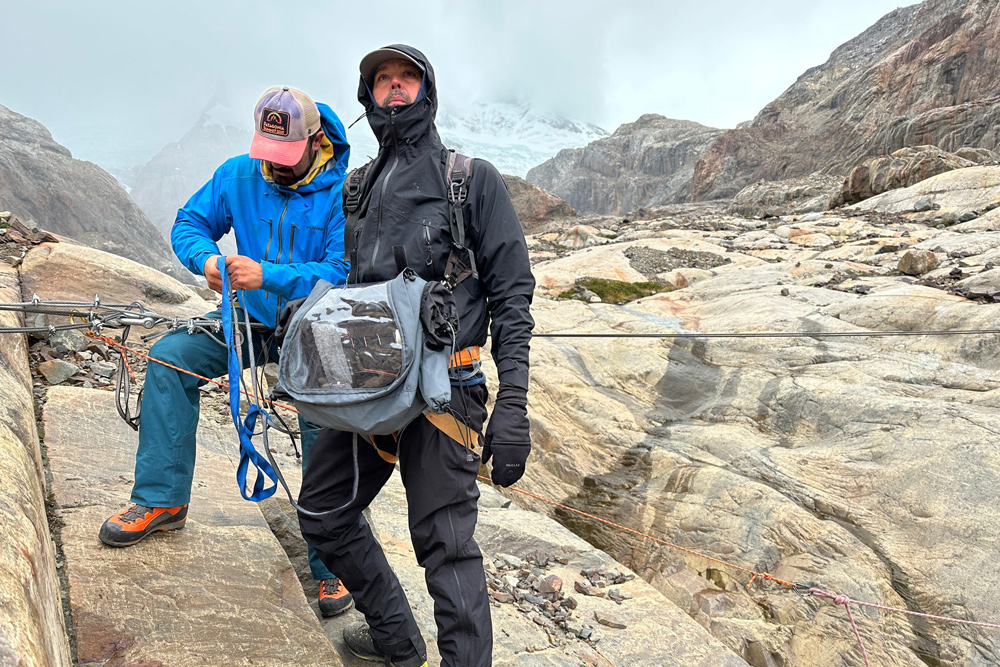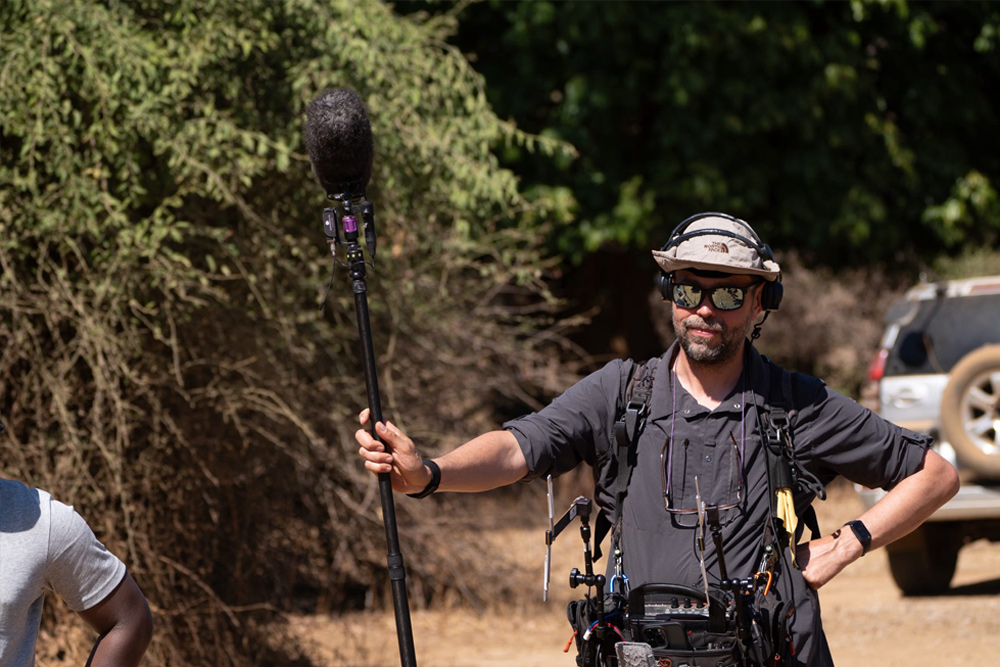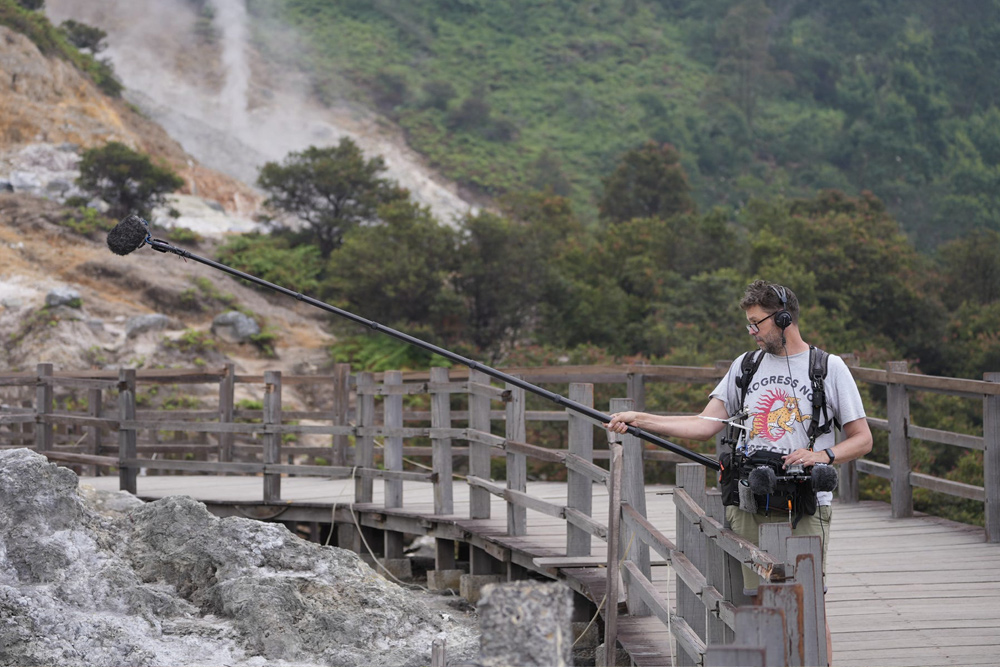
Preproduction can be a matter of life or death for sound mixer Aj Butterworth who has traveled to some of the most remote and dangerous locations in the world recording audio. For over 25 years, the UK-based sound recordist and sound supervisor has worked on all types of shows and genres from documentary, reality television, scripted dramas, corporate work, and music videos, but travel work is something he particularly enjoys.
“When I was in my teens I’d watch shows on the BBC and I became obsessed with the idea of adventure and the romance of getting on a plane, flying off to Cairo, filming some stuff, and then heading somewhere else. It seemed like an incredible thing to do,” he says. “When I travel now, I feel privileged to have seen the things I’ve seen and I still have to pinch myself when I end up in another far-flung part of the planet.”
Butterworth’s passion for sound started even earlier as a child when his parents bought him a Fergusson cassette recorder. “It had this mic with a coiled cable and I started recording things like the washing machine, interviewing the dogs, or just recording effects and playing around with that kind of stuff. I think I was the only kid who ever took sound effects albums out of the library.”
Since, Butterworth has built an outstanding career with over 100 credits to his profession and has even become a licensed drone pilot along the way. Taking part in his success is a Zaxcom kit that includes the Nova mixer-recorder and Zaxcom transmitters, receivers, and IFB systems. Below, he shares some of his globe-trotting adventures, insights into his workflows, and why he chose the gear he records with today.
Do you remember when you realized recording sound was something you could do professionally?
I grew up watching shows like Whickers World, Holiday, and when I was in my late teens, shows like Rough Guide and Lonely Planet which I went on to work on. But there were two series in the UK that drove me to become a recordist and they were Around the World in 80 Days and Pole to Pole, both with Michael Palin, the Monty Python writer. I remember watching those series and thinking that’s the coolest job in the world. You get to travel to these incredible places and film such amazing stories. And I remember watching the credits and seeing the recordist’s name, and that’s when I decided that that was the job for me. It didn’t seem real that I could combine my love for sound and travel and get paid for it. So thank you Fraser Barber!

You haven’t always been a Zaxcom user. Was there a show that piqued your interest about the gear?
I used it on a show called Jamie’s Dream School, and from a technical point of view, it was a real challenge. We had 20 or so kids who would go into his summer school, kids who hadn’t done well in the traditional school system. It was an experiment to show that with the right kind of environment, and the right kind of teaching, kids will flourish. What they had were smaller classes and they would get incredible teaching from celeb teachers – Jazzie B for music and Dominic West and Simon Callow for acting.
In the UK we are very squeezed with the amount of spectrum we can operate in using radios without extra licenses or extra receivers. Wideband was just a dream then, and with all the kids, teachers, and everyone involved, the problem then was how do we get upwards of 30 people all on radios in the bag. There was no option to rig the entire school for RF and run it back to a control room because there simply wasn’t the money available. Plus, we had to be as mobile as possible as quite a lot of the show would take place off campus.
How did you end up recording that series?
There was another recordist working on the show with me, a lovely recordist named Jeff Hawkins, and it was he who suggested Zaxcom ZFRs. They had just come out I think. He said to me, have you seen these Zaxcom ZFR recorders? I said I hadn’t but they looked interesting. So a week before we started shooting I met Roger Patel from Everything Audio, Roger’s the Zaxcom distributor here in the UK. After Roger showed me the setup, I was impressed so I convinced production to go with it. Initially, they were like, hang on. We can’t hear what they’re saying, you can’t feed us any of the audio, and at the end of the day, you’ll magically take a card out and it’s going to have sound on it with timecode. I nodded and said, trust me, it’ll work. And you know what? It worked. I think that was the first production in the UK to use that many standalone ZFRs. It was a real seat of your pants first few days but it saved the show.

Is that when you went full Zaxcom?
Not straight away. It wasn’t until I did a show called The Moaning of Life with Karl Pilkington. Moaning was a comedy travel show. I came onto it in the second series and in the first series they had two packs on Karl, one a radio mic and a ZFR. And to be honest, I didn’t want to have to worry about two packs, two sets of batteries, and rigging two mics, so I bit the bullet and bought my first load of Zaxcom TRXLA3’s and QRX receivers. Zaxcom made a huge difference to my workflow. We have the RF feed from the packs to feed production via an IFB200 into the ERX ZaxNet receivers that production uses for IFB’s so everyone was able to hear what’s going on. But if Karl or anyone went off in a vehicle, we were covered because of the internal recording on the Zaxcom wireless. For me that was it, there was no turning back.
You’ve traveled to many different countries in your career. Do you have a favorite passport stamp?
I don’t know. I’ve still got all my old passports with Iranian visas, stamps from Chile, stamps from Russia, stamps from pretty much everywhere, but there are still a few spots on the globe that I haven’t been to. Maybe the remote trips to places like Patagonia are my favorites; when you are in a place that feels like a timeless landscape. It looked that way 2 million years ago, 50 million years ago, and the sounds are pretty much the same then as they are now, apart from the very occasional plane.
Speaking of Patagonia, you went there for the series Wilderness with Simon Reeve. What type of prep goes into working at such a remote location?
With Patagonia we met up on Zoom first of all to talk about initial story ideas… what we are planning to do, where we are planning to go, and any technical things that arise from that conversation. Our local fixing team would also be there and they are the most important members of the team in a way. A shoot can live or die, literally, by the fixers that are on it.
Everyone has to have an understanding that this isn’t just getting on a plane and going off on holiday. This is a serious expedition. In Patagonia we were summiting the southern ice field which is a gnarly environment. Making sure that you all meet up and understand how each other works is really important in preproduction. I would feel uncomfortable getting on a plane if I hadn’t met everyone before because I’m putting my trust and sometimes my life in their hands and vice versa. There’s no kind of demarcation on those jobs, everyone is responsible for everyone else.
What was the technical workflow on Wilderness with Simon Reeve?
My main recorder is a Zaxcom Nova. I use MRX414 receivers to pair with any number of Zaxcom transmitters I have at my disposal. I make the most of ZaxNet on the Nova and use it to feed audio to my ERX’s for production to monitor audio and to control the settings on my transmitters. For this show, Simon was wired with a TRXLA5 so we could get a longer runtime out of AA batteries if the situation required it. I’d mic’d him with a DPA 6060 or a 6061, which are my favorite lav mics. They are easy to hide, sometimes even in plain sight, which always makes life easier.
I also use a wireless boom on the majority of my shoots, paired with a ZMT4 transmitter and a Sanken CS-M1 in a Cosi on a VDB boompole – having minimal cables hanging out of the bag is helpful, especially if you’re jumping in and out of vehicles. Both cameras on the show have CS-M1’s on them as Simon was often inside a vehicle, especially in places like the Kalahari when I know he would deliver a lot of PTC’s (piece to camera) over his shoulder to our producer Chris Mitchell who’s riding in the back of the vehicle. So his lav mic is often off-axis and not the best option and as there’s not enough space for me, the CS-M1 does a lot of the hard work in those situations. These shoots are very much set-and-forget type of rigs. You need to get your mic in the optimal spot first time and keep fussing to a minimum. Keeping the kit footprint small helps on these shows.
Anything specific about the Nova that stands out over other recorders?
The size. I mean, my kit now is just over five kilos. I’ll see recordists now who have these huge bags and they’ve got eight receivers and IFB transmitters and they’ve got two iPads stuck to them. And they moan about how much their back hurts. And I’ve got this tiny little bag. I’ve got eight channels of radio mics built into it, 16 if I want. Why would you want to do anything else? I’m transmitting audio to production. I’m transmitting timecode and adjusting the gain setting to my recorders.
You mentioned Kalahari. In that episode of Wilderness with Simon Reeve you track down wildebeest with locals. How do you approach the quiet hunt?
We’re with two sets of tribes, the San bushmen, who are incredible hunters. We split off into two separate units. Myself and producer Chris Mitchell would go with Simon and four or five hunters. Then a second unit would go with DP Piers Leigh with another set of hunters. We’d also have, Dam, our translator with us who translates everything the Bushmen are saying. The San communicate through a language based on clicks, pops and other sounds, it’s incredible to listen to. Everyone is wearing Zaxcom wireless and we’re following slightly back from what’s going on because the less noise we can make the better while the San are hunting.
So, I’ll be back with Chris and the translator doing a live translation for Chris as to what’s going on. I’ll record the live translation to an ISO which means the edit will know exactly what’s going on and that’s how we played it and it worked well. I had every confidence that if the other hunting party had success with their hunt, we’d get all that audio and it would all tie and match up with their camera rushes as I put an extra IFB transmitter with them so the timecode was constant throughout the shoot with our unit. This way, I’m kind of overseeing two units at once but only being with one of them.
What Zaxcom transmitters did you end up using?
Most of them were on TRXLA5 transmitters, so we were running 11 hours on lithium batteries. So by the time we returned there’d be two takes for the whole day and that would be it. My biggest job on the show was being my own DIT on the shoots.

Another series you’ve traveled for is World’s Most Dangerous Roads which airs on UKTV’s U&Dave . Any of the episodes stick out to you?
I think in terms of location, Sri Lanka was one of my favorites. I love the landscape, the food, the climate, the culture, I love everything about it.
The Sri Lanka episode had beloved soccer hosts Jeff Stelling and Chris Kamara traveling across the country. How did you rig the vehicle they drove around in?
It’s changed a lot from the first series. The original rig would take several hours, now I’ve got it down to just a couple. I’ve stripped it all back and made the most out of the smaller ZMT4 transmitters. I have ZMT4s on both of our principles and ZMT4s overhead in each visor with DPA gooseneck mics. Everything’s wireless in there and is backed up to the internal cards on the transmitters. Plus the ISOs on another mixer, so if one thing stops working we have backups. I also have Sanken Cub mics on the interior and exterior of the vehicles to catch great exterior atmospheres. My entire approach to the show is about redundancy, if one thing fails, then there’s something else in place to catch it because there’s no time for retakes.
What have you learned over the years mixing in such isolated environments?
Every job is very different for me. I think you’d be complacent to say they’re all the same. On Wilderness, it’s very much about Simon as a host and his journey, things can change in an instant and new contributors can be introduced, so you need to be on your toes and it’s understanding the craft and the skills you’ve acquired through years of experience as to how to deal with situations as they arise. Just looking at people, knowing where a mic can go, where a wireless pack can go and what the possible problems could be. I like to keep it as simple as I possibly can. Why make life harder in an already challenging location?
Before we let you go, is there a feature you’d like to see developed for your Zaxcom kit?
PFL in the RX page! But no, I think at the moment how they’re adding to ZaxNet by bringing in VHF as well as 2.4ghz is a great leap, longer range for IFBs, and still having ZaxNet for radio mic control is a big bonus for me.
The great thing with Zaxcom, and all the major kit manufacturers, is if I have an issue with something it’s usually sorted quickly. I know I can email Zaxcom and I’ll get a reply. They care about their users out in the field. It’s their business and there’s a real online community of Zaxcom users that you can all tap into when we need an answer quickly. They’re such an innovative company and that’s why I’m a big fan.
You can follow more of his work on his website or Instagram.